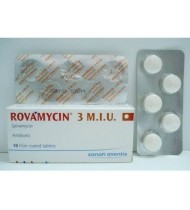Spiramycin
Indications
Spiramycin is indicated for the treatment of infections of the respiratory tract, buccal cavity, skin and soft tissues due to susceptible organisms. Neisseria gonorrhoeae: as an alternate choice of treatment for gonorrhea in patients allergic to the penicillins. Before treatment of gonorrhea, the possibility of concomitant infection due to T. pallidum should be excluded.
Description
Spiramycin is a macrolide antibiotic produced by Streptomyces ambofaciens. It is active against the following Gram-positive organisms: Staphylococcus aureus (including penicillin resistant strains), ß-haemolytic streptococci, Streptococcus viridans, Streptococcus faecalis and Streptococcus pneumoniae, Corynebacterium diphteriae, clostridia. Except for Bordetella pertussis, Hemophilus influenzae (approximately 50% of strains) and neisseria, gram-negative organisms are generally considered as resistant to spiramycin. Bacterial resistance to spiramycin has been reported to develop, including cross-resistance between spiramycin and erythromycin. However, most of the erythromycin-resistant strains of S. aureus are still sensitive to spiramycin.
Pharmacology
The mechanism of action of macrolides has been a matter of controversy for some time. Spiramycin, a 16-membered macrolide, inhibits translocation by binding to bacterial 50S ribosomal subunits with an apparent 1 : 1 stoichiometry. This antibiotic is a potent inhibitor of the binding to the ribosome of both donor and acceptor substrates. The primary mechanism of action is done by stimulation of dissociation of peptidyl-tRNA from ribosomes during translocation.
Dosage
Adult: 6 to 9 Million International Units per 24 hours, in 2 divided doses. In severe infections, the daily dosage may be increased to 12 to 15 Million International Units per day. Gonorrhea: 12 to 13.5 Million International Units in a single dose.
Children: The usual daily dosage is based on 150,000 l.U./kg body weight in 2 or 3 divided doses.
Children: The usual daily dosage is based on 150,000 l.U./kg body weight in 2 or 3 divided doses.
Administration
Spiramycin is stable in gastric juices and absorption is not affected by food. In severe infections, the daily dosage may be increased by one half. In the treatment of beta hemolytic streptococcal infections, adequate Spiramycin dosage should be administered for 10 days.
Interaction
Rovamycine has been reported to inhibit the absorption of carbidopa and decrease levodopa plasma levels. When necessary, patients should be closely monitored and the levodopa dosage levels adjusted.
Contraindications
Spiramycin is contraindicated in patients with known hypersensitivity to the drug. The levels of spiramycin attained in the cerebrospinal fluid are much lower than those in the blood and are too low to be clinically useful. Therefore Spiramycin must not be used in patients with meningitis.
Side Effects
Side effects of include: nausea, vomiting, diarrhea, inflamed bowels, pruritus (itchy skin), tingling or numbness in the skin.
Pregnancy & Lactation
Safety of this product for use during pregnancy has not been established.
Precautions & Warnings
Administer antibiotics, including Spiramycin cautiously to any patient who has demonstrated some form of allergy, particularly to drugs. The possibility of superinfection caused by overgrowth of nonsusceptible organisms should be kept in mind during prolonged or repeated therapy. If superinfection occurs, discontinue the drug and take appropriate measures.
Overdose Effects
No case of accidental overdosage has been reported. In oral doses over 4 gm per day, abdominal discomfort, nausea or diarrhea may occur. No specific treatment has been proposed. Management should be symptomatic
Therapeutic Class
Macrolides
Storage Conditions
Store in a dry place between 15ºC and 30ºC.
Rovamycine Tablet 3 MIU
IndicationsSpiramycin is indicated for the treatment of infections of the respiratory tract, buccal ..
20.13Tk.
Showing 1 to 1 of 1 (1 Pages)

